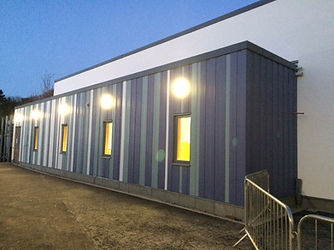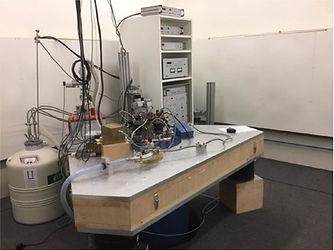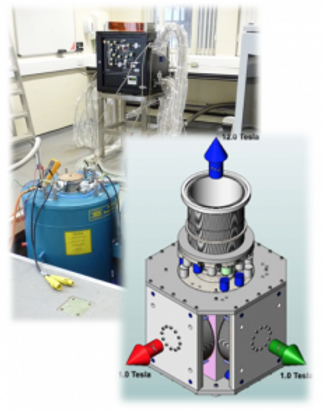
Research
Our Approach
Within the Centre for Designer Quantum Materials, we combine atomic-scale materials synthesis with state-of-the art spectroscopic and thermodynamic probes and theoretical modelling to take a targeted approach to understanding and designing new quantum electronic states in solids. Click on the images below to find out more about our approach, or read about some of our current research interests and how you can access our unique facilities. We also have a more general introduction to what we do for non-scientists.
Our Research
Designer Oxides
One of the most active challenges of modern solid state physics and chemistry is harnessing the unique and varied physical properties of transition-metal oxides. Subtle collective quantum states underpin their diverse properties. These complicate their physical understanding but render them extremely sensitive to their local crystalline environment, offering enormous potential to tune their functional behaviour. They are therefore not only an exciting playground for study of the quantum many-body problem in solids, but also, if properly controlled, a powerful platform for future technologies. They provide almost unlimited scope to design new materials with almost arbitrary properties, exploiting powerful tuning parameters such as quantum confinement and epitaxial strain. Combining these via superlattice creation, forming new "metamaterials" which do not have any analogue in bulk form, holds enormous potential to stabilise new electronic, magnetic, and thermodynamic states and phases. Their complexity, however, means we are still far from able to dial-up a desired property at will.

Within the Centre for Designer Materials, we combine growth of thin films and heterostructures of transition-metal oxides with near atomic precision, and study the electronic states and phases that we create with our unique combined in situ spectroscopy capabilities as well as powerful ex situ thermodynamic, transport, microscopic, and spectroscopic probes. We are interested in the beautiful physics that these systems possess, but also motivated by their potential widespread technological impact, in areas spanning from heterogeneous catalysis to novel quantum electronics.
2D Quantum Materials

Two-dimensional materials (2DMs), that can be as thin as a single atom, represent fundamental building blocks for creating new advanced materials. Widespread interest in these systems has been spurred by the remarkable properties of graphene, and more recently semiconductors such as MoS2. We are interested in developing methods to additionally exploit, and ultimately control, strong electronic interactions, to pave the way for a new generation of 2D quantum materials (2DQMs). Enormous strides in band structure engineering have already been achieved by stacking together different weakly-interacting 2D
materials, realising functional devices such as tunnelling transistors and chiral light emitters. Additionally harnessing strong correlations promises much greater tuneability: combining strongly-interacting 2DQMs in different configurations and environments will yield rich phase diagrams and dramatically-enhanced functional properties, but predicting their emergent properties is extremely challenging. To this end, we combine experimental screening of candidate building blocks, bottom-up atomic assembly of their custom heterostructures, and advanced spectroscopic and thermodynamic feedback to develop an integrated approach to their targeted design.
Unconventional superconductivity
We are interested in searching for unconventional superconductors with a significant spin-triplet component of the superconducting order parameter. We induce these via proximity effects at ferromagnet-superconductor interfaces, as well as studying superconductivity induced in topological surface states and in non-centrosymmetric materials. We study topological superconductivity theoretically, and develop schemes for stabilising Majorana zero modes and for the generation and detection of entanglement, with a view to future quantum technologies.

Bulk correlated materials

We collaborate with some of the leading physicists, materials scientists and solid state chemists from around the world, studying their single-crystal samples within our state-of-the-art measurement and characterisation facilities. We not only investigate these to understand the underlying many-body interactions of the parent compounds for fabricating designer quantum materials, but seek to tune the properties of the bulk compounds through strategies such as extrinsic charge carrier doping and uniaxial strain control. Current systems of interest include Fe-based superconductors, Delafossite oxide metals, and transition-metal dichalcogenides.
Materials synthesis
We operate two DCA R450 molecular-beam epitaxy systems, optimised for the growth of transition-metal oxides and chalcogenides, respectively. They enable the atomically-precise growth of thin-films and heterostructure of a wide array of different compounds, including hybrid oxy-chalcogenides via a direct ultra-high vacuum connection between the growth modules. Core specifications include:
Oxide MBE:
-
Distilled ozone as oxidant
-
10 differentially-pumped effusion cells, allowing for high-pressure ozone growths and rapid exchange of source materials
-
4-pocket e-beam evaporator with EIES flux control
-
In-situ RHEED monitoring
-
High-temperature ozone-resistant sample manipulator, taking substrates of up to 2" diameter
Chalcogenide MBE:
-
Up to 9 shuttered effusion cells
-
3-pocket e-beam evaporator
-
Valved cracker for Se/Te evaporation
-
In-situ RHEED monitoring
-
Sample manipulator, taking substrates of up to 2" diameter

Photo © Tricia Malley Ross Gillespie www.broaddaylightltd.co.uk
Both MBEs are connected via in-vacuum transfer to our spectroscopic tools for angle-resolved photoemission and scanning tunnelling microscopy, and samples can be removed into a vacuum suitcase for transfer to a wide range of other experimental capabilities.
Spectroscopy
Ultra-low vibration laboratories
The centre houses the UK's only dedicated suite of ultra-low vibration (ULV) laboratories for scanning probe spectroscopy. These are located in their own building which houses four separate rooms, each of which feature a 17 tonne concrete slab which rests on air springs for vibration isolation as well as a double-walled hull to block out acoustic noise. The experiments are controlled from a dedicated control room which is mechanically decoupled from the labs to ensure that work carried out in the building does not impact on experiments.
Scanning Tunnelling Microscopy and Spectroscopy
The ULV labs currently house three spectroscopic-imaging scanning tunnelling microscopes (STMs), with a fourth one currently under construction. These enable atomic-scale imaging and spectroscopy of quantum materials. They operate in cryogenic ultra-high vacuum and are optimized for high stability and a long continuous measurement time. They are linked to the materials synthesis capabilities of the CDQM via vacuum suitcase transfer, enabling the low-temperature STM study of designer thin-film quantum materials. The instrument capabilities include:
-
A liquid helium bath cryostat system with a 16T superconducting magnet. The STM operates at temperatures from 1.6K to ~50K.
-
A dilution fridge-based STM mounted in a 14T superconducting magnet, which can operate at temperatures down to below 20mK.
-
A 1.6K vector magnet system, allowing for fields of up to 5T being applied in any direction with respect to the sample as well as up to 9T normal to the sample surface. The instrument is prepared for a combined STM/AFM head to allow also for studies of poorly conducting and insulating materials, as well as for multiple sample contacts.
Angle-resolved Photoemission Spectroscopy
Angle-resolved photoemission spectroscopy (ARPES) is a powerful probe of the momentum-dependent electronic structure and many-body interactions in solids. We operate the only lab-based ARPES system suitable for the study of quantum materials in the UK. To system's capabilities include:
-
A high-resolution Specs Phoibos 225 hemispherical electron analyser, combined with a high-intensity He plasma lamp with rotatable linear polarization. With this setup, we routinely achieve energy resolutions of 3-10 meV;
-
A tuneable laser source, based around the APE HarmoniXX harmonic generation, providing 190-210nm photons with 80MHz rep. rate;
-
A monochromatized Al K𝛼 X-ray source permitting X-ray photoemission spectroscopy measurements of core levels and valence band density of states with a resolution better than 300 meV;
-
An ultra-high vacuum (< 5 x 10-11 mbar) sample environment, with the sample held on a 6-axis manipulator where it can be cooled to 4 K;
-
Capabilities for in situ sample cleavage, preparation by sputter and annealing in a dedicated preparation chamber, and in situ transfer from the materials synthesis capabilities of the CDQM within an all-UHV sample transfer environment.
Spin- and Angle-resolved Photoemission Spectroscopy
A new capability for spin-resolved ARPES (the first of its kind in the UK) is currently in the design phase, and we expect this to become operational mid- to late-2019.
Spectroscopy at Central Facilities
We are regular users of major international facilities in the UK and abroad. In recent years, we have had regular beamtimes at: Diamond Light Source, ISIS, Elettra, S𝜇S, SLS, SOLEIL, and HiSOR synchrotron, neutron, and muon sources. These studies complement our in-house spectroscopic measurements, and enable the use neutron and x-ray scattering and muon spin rotation spectroscopy as powerful microscopic probes of quantum materials.
Thermodynamics and Transport
We have a variety of bespoke and commercial tools for probing the transport and thermodynamic properties of quantum materials. This includes a 3D Vector magnet (9T/1T/1T) allowing for arbitrary magnetic paths in parameter space. This system can be used with both a fast turnaround dilution refrigerator insert (base temperature of 40mK) and a variable temperature insert (VTI) covering the temperature range up to room temperature. High precision magnetoconductivity measurements are implemented in all inserts, while for thermodynamic experiments we are implementing a new bespoke experimental platform tailored to thin-film materials, enabling measurements of magnetisation, magnetotorque, specific heat and the magnetocaloric effect in designer Quantum materials. A flow cryostat resistivity rig and Quantum Design MPMS are also available within the centre.
Materials Characterisation
We utilise a range of additional characterisation techniques, including within St Andrews' Electron Microscopy facility and within the Advanced Functional Materials Research Centre, as well as with external collaborators.


More information

Prof. Peter Wahl

More information

Prof. Phil King
More information

Prof. Steve Lee

More information

Access our facilities
Dr. Andreas Rost
Our capabilities for materials synthesis operate as a user facility, providing access for collaborators and external users. User access is charged on an hourly basis, with different rates for academic and commercial users, and is fully supported by an experienced technician. If you are interested in using our facility, please contact us at cdqm@st-andrews.ac.uk in the first instance, or fill in this form for requesting growth of a specific heterostructure. Growth requests will be honoured were possible, after evaluating feasibility, fit with available growth materials and priorization against other pending requests.
Once operational, the facility for spin- and angle-resolved photoemission spectroscopy will also operate as a shared user facility, with an annual call for proposals as well as a rapid-access mode. More details will be provided here in due course.
If you are interested in using any of our other facilities, or to collaborate with us on measurements performed using the Centre's bespoke instrumentation, please contact us at cdqm@st-andrews.ac.uk.
Theory
We combine a range of theoretical approaches to study the theory of quantum materials, including their many-body interactions and topological entanglement structures, with a view to understanding the properties of existing systems and predicting materials combinations or device structures for designer quantum materials. Our methods range from analytical to numerical, such as functional renormalisation group and matrix product state calculations. We also collaborate with leading theorists outside of the Centre, including those developing and utilising state-of-the-art ab initio techniques and incorporating effects of many-body interactions within these.
More information

Dr. Bernd Braunecker

Quantum many body physics, ultracold atomic gases, complex temperatures, non-equilibrium Kondo model
Dr. Chris Hooley



What we do - for non-scientists
The world around us is governed by materials, from the steel that we use to build bridges and buildings to the silicon that forms the basis of computer chips at the heart of so many modern technologies. Today, we are undoubtedly in the "silicon age", but just as the Stone Age gave way to the Bronze Age and then Iron Age, new materials will emerge that surpass the properties and use of Silicon. We are a group of scientists interested in understanding, and ultimately designing, such materials of the future. To do this, we build up new materials a single atom layer at a time, and study how their electrons behave using sensitive experimental probes that can image single atoms, that can build up road-maps for how the electrons move, and that can determine how large numbers of their electrons behave to give rise to some of the most spectacular, but still poorly understood, properties of materials that are known today. We work together with theorists, who model how materials behave and design new structures that could lead to devices of the future. The videos below, prepared with some of our collaborators, give a general introduction to what we do and why. You can also find some more information in recent features on our centre on the BBC, Scottish TV, and Scottish press.
Centre for Designer Quantum Materials


TOPNES - Making And Looking Inside Matter

TOPNES - Looking Inside Materials Using Light

TOPNES - Looking Inside Materials Using A Microscope

TOPNES - Looking Inside Materials Using Muons

TOPNES Topological Properties Of Electrons In Materials

TOPNES - What Is Topology, And Why Does It Matter?
Header photo © Tricia Malley Ross Gillespie www.broaddaylightltd.co.uk
